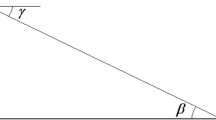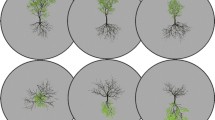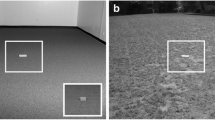Abstract
People judged the inclination of hills viewed either out-of-doors or in a computer-simulated virtual environment. Angle judgments were obtained by having people (1) provide verbal estimates, (2) adjust a representation of the hill’s cross-section, and (3) adjust a tilt board with their unseen hand. Geographical slant was greatly overestimated according to the first two measures, but not the third. Apparent slant judgments conformed to ratio scales, thereby enhancing sensitivity to the small inclines that must actually be traversed in everyday experience. It is proposed that the perceived exaggeration of geographical slant preserves the relationship between distal inclination and people’s behavioral potential. Hills are harder to traverse as people become tired; hence, apparent slant increased with fatigue. Visually guided actions must be accommodated to the actual distal properties of the environment; consequently, the tilt board adjustments did not reflect apparent slant overestimations, nor were they influenced by fatigue. Consistent with the fact that steep hills are more difficult to descend than to ascend, these hills appeared steeper when viewed from the top.
Article PDF
Similar content being viewed by others
Avoid common mistakes on your manuscript.
References
Braunstein, M. L. (1968). Motion and texture as sources of slant information.Journal of Experimental Psychology,78, 247–253.
Bridgeman, B., Lewis, S., Heit, G., &Nagle, M. (1979). Relationship between cognitive and motor systems of visual position perception.Journal of Experimental Psychology: Human Perception & Performance,5, 692–700.
Bruner, J. S., &Goodman, C. C. (1947). Value and need as organizing factors in perception.Journal of Abnormal & Social Psychology,42, 33–44.
Bruner, J. S., &Rodrigues, J. S. (1953). Some determinants of apparent size.Journal of Abnormal & Social Psychology,48, 17–24.
Clark, W. C., Smith, A. H., &Rabe, A. (1956a). The interaction of surface texture, outline gradient, and ground in the perception of slant.Canadian Journal of Psychology,10, 1–8.
Clark, W. C., Smith, A. H., &Rabe, A. (1956b). Retinal gradients of outline distortion and binocular disparity as stimuli for slant.Canadian Journal of Psychology,10, 77–81.
Epstein, W. (1981). The relationship between texture gradient and perceived slant-in-depth: Direct or mediated?Perception,10, 695–702.
Epstein, W., &Mountford, D. (1963). Judgments of slant in response to an isolated gradient of stimulation.Perceptual & Motor Skills,16, 733–737.
Epstein, W., &Park, J. N. (1963). Shape constancy: Functional relationships and theoretical formulations.Psychological Bulletin,60, 265–288.
Eriksson, E. S. (1964). Monocular slant perception and the texture gradient concept.Scandinavian Journal of Psychology,5, 123–128.
Farah, M. (1990).Visual agnosia. Cambridge, MA: MIT Press.
Ferrera, V. P., Nealey, T. A., &Maunsell, J. H. R. (1994). Responses in macaque visual area V4 following inactivation of the parvocellular and magnocellular LGN pathways.Journal of Neuroscience,14, 2080–2088.
Flock, H. R. (1964). Some conditions sufficient for accurate monocular perceptions of moving surface slants.Journal of Experimental Psychology,67, 560–572.
Flock, H. R., Graves, D., Tennet, J., &Stepehenson, B. (1967). Slant judgments of single rectangles at a slant.Psychonomic Science,7, 57–58.
Foley, J. M. (1977). Effect of distance information and range on two indices of visually perceived distance.Perception,7, 449–460.
Foley, J. M. (1980). Binocular distance perception.Psychological Review,87, 411–434.
Freeman, R. B. (1966a). Absolute threshold for visual slant: The effect of stimulus size and retinal perspective.Journal of Experimental Psychology,71, 170–176.
Freeman, R. B. (1966b). The effect of size on visual slant.Journal of Experimental Psychology,71, 96–103.
Gibson, J. J. (1950). The perception of visual surfaces.American Journal of Psychology,63, 367–384.
Gibson, J. J. (1979).The ecological approach to visual perception. Boston: Houghton Mifflin.
Gibson, J. J., &Cornsweet, J. (1952). The perceived slant of visual surfaces— optical and geographical.Journal of Experimental Psychology,44, 11–15.
Gillam, B. (1970). Judgments of slant on the basis of foreshortening.Scandinavian Journal of Psychology,11, 31–34.
Goodale, M. A., &Milner, A. D. (1992). Separate visual pathways for perception and action.Trends in Neurosciences,15, 20–25.
Kammann, R. (1967). The overestimation of vertical distance and slope and its role in the moon illusion.Perception & Psychophysics,2, 585–589.
Kinsella-Shaw, J. M., Shaw, B., &Turvey, M. T. (1992). Perceiving walk-on-able slopes.Ecological Psychology,4, 223–239.
Kraft, A. L., &Winnick, W. A. (1967). The effect of pattern and texture gradient on slant and shape judgments.Perception & Psychophysics,2, 141–147.
Li, W., &Matin, L. (1993, November).Prism-generated and real pitch influence egocentric localization similarly; prism generated and real slant don’t. Poster presented at the meeting of the Psychonomic Society, Washington, DC.
Loomis, J. M., Da Silva, J., Fujita, N., &Fukusima, S. S. (1992). Visual space perception and visually directed action.Journal of Experimental Psychology: Human Perception & Performance,18, 906–921.
Matin, L., &Fox, C. R. (1989). Visually perceived eye level and perceived elevation of objects: Linearly additive influences from visual field pitch and from gravity.Vision Research,29, 315–324.
Matin, L., &Li, W. (1992). Visually perceived eye level: Changes induced by a pitched-from-vertical 2-line visual field.Journal of Experimental Psychology: Human Perception & Performance,18, 257–289.
McCurdy, H. G. (1956). Coin perception and the concept of schemata.Psychological Review,63, 160–168.
Murray, W. H. (1947).Mountaineering in Scotland. London: Dent.
Nealey, T. A., &Maunsell, J. H. R. (1994). Magnocellular and parvocellular contributions to the responses of neurons in macaque striate cortex.Journal of Neuroscience,14, 2069–2079.
Perrone, J. A., &Wenderoth, P. M. (1991). Visual slant underestimation. In S. R. Ellis (Ed.),Pictorial communication in virtual and real environments (pp. 496–503). London: Taylor & Francis.
Phillips, R. J. (1970). Stationary visual texture and the estimation of slant angle.Journal of Experimental Psychology,22, 389–397.
Robinett, W., &Rolland, J. (1991). A computational model for the stereoscopic optics of a head-mounted display.SPIE Proceedings: Stereoscopic displays and applications II,1457, 140.
Ross, H. E. (1974).Behavior and perception in strange environments. London: George Allen & Unwin.
Schneider, G. E. (1969, February 28). Two visual systems.Science,163, 895–902.
Smith, A. H. (1966). Phenomenal slant as a function of ambiguity of contour perspective.Perceptual & Motor Skills,23, 587–594.
Smith, A. H. (1967). Perceived slant as a function of stimulus contour and vertical dimension.Perceptual & Motor Skills,24, 167–173.
Stoper, A. E., &Cohen, M. M. (1989). Effect of structured environments on apparent eye level.Perception & Psychophysics,46, 469–475.
Stoper, A. E.,Fries, C., &Bautista, A. (1992, November).The effect of environmental pitch on apparent slant. Paper presented at the meeting of the Psychonomic Society, St. Louis.
Tajfel, H. (1957). Value and the perceptual judgment of magnitude.Psychological Review,64, 192–204.
Ungerleider, L. G., &Mishkin, M. (1982). Two cortical visual systems. In D. J. Ingle, M. A. Goodale, & R. J. W. Mansfield (Eds.),Analysis of visual behavior (pp. 549–586). Cambridge, MA: MIT Press.
Willey, R., &Gyr, J. W. (1969). Motion parallax and projective similarity as factors in slant perception.Journal of Experimental Psychology,79, 525–532.
Author information
Authors and Affiliations
Corresponding author
Additional information
This research was supported by NIMH Grant MH5240-01 and NASA Grant NCC2-5074 to the first author. The authors are very grateful for the assistance provided by Marco Bertamini, Bennett Bertenthal, Sarah Creem, Jim Durbin, Frank Durgin, Jane Joseph, and Shahwar Qureshi. The development of our ideas benefitted greatly from numerous conversations with Jack Loomis. Nicola Bruno, William Ittelson, and Johan Wagemans provided valuable criticism on an earlier version of this paper.
Rights and permissions
About this article
Cite this article
Proffitt, D.R., Bhalla, M., Gossweiler, R. et al. Perceiving geographical slant. Psychon Bull Rev 2, 409–428 (1995). https://doi.org/10.3758/BF03210980
Received:
Accepted:
Issue Date:
DOI: https://doi.org/10.3758/BF03210980




